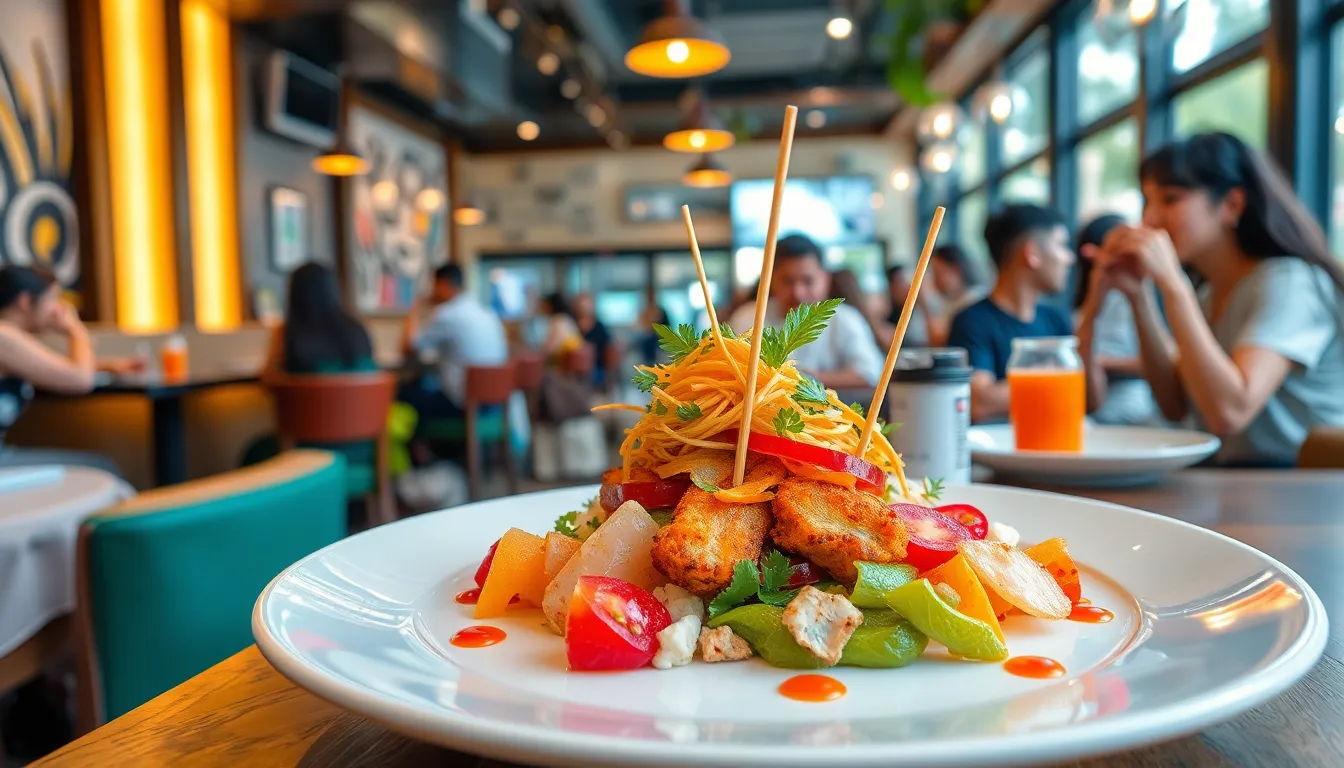Table of Contents
ToggleIn a world where food can become an overnight sensation, viral food trends are the new culinary rockstars. From rainbow bagels to whipped coffee, these edible phenomena capture hearts and taste buds, often leaving a trail of Instagram posts in their wake. It’s not just about eating; it’s about sharing the experience that turns a simple meal into a social media spectacle.
What Is Viral Food?
Viral food refers to dishes that gain immense popularity through social media platforms. Characteristics of these foods include unique presentations, vibrant colors, and innovative ingredients. Meals like rainbow bagels and whipped coffee exemplify this trend, appealing to audiences due to their striking visuals.
Social media plays a crucial role in promoting viral food. Users share photos and videos, creating excitement and interest among their followers. A simple post can result in widespread attention, making previously obscure dishes household names. Engagement often leads to significant spikes in demand for these trending items at restaurants and cafes.
Cultural influences also contribute to the viral status of certain foods. Fusion cuisines merge different culinary traditions, attracting diverse crowds and generating buzz. Seasonal themes, such as pumpkin spice in fall, often revive interest in specific dishes.
Additionally, viral food connects with consumer preferences emphasizing experience over sustenance. People enjoy documenting their meal experiences, often involving friends and family in the process. Shareable moments become a key element, driving individuals to seek out the latest food trends.
As a result, restaurants and food vendors adapt to capitalize on these trends. They create menu items designed specifically for social media, ensuring appeal on platforms like Instagram and TikTok. Successful viral food not only satisfies taste buds but also fulfills the desire for shareable, visually striking content online.
Viral food encapsulates the intersection of culinary creativity and social media engagement. Each dish actively shapes trends and cultural moments, emphasizing the power of visual storytelling in food culture.
The Rise of Viral Food Trends

Viral food trends have transformed culinary experiences into shareable social media moments. Unique presentations and vibrant colors define these dishes, attracting attention and generating excitement online.
Social Media Influence
Social media platforms drive the popularity of viral foods. Users post photos and videos, showcasing visually striking meals that encourage others to try them. Engaging content prompts comments and shares, building a sense of community around food. Hashtags often play a crucial role, making trending dishes easily discoverable. Restaurants benefit from this exposure, adjusting their offerings to cater to the demand for Instagram-worthy creations. The more captivating the visual, the higher the likelihood of it going viral.
Popular Platforms for Viral Food
Various platforms contribute to the spread of viral food trends. Instagram, with its focus on imagery, allows users to display colorful dishes that capture attention. TikTok’s short videos offer a platform for cooking demonstrations and creative meal presentations. Facebook facilitates sharing among friends, creating discussions around popular dishes. Pinterest serves as an inspiration source where users search for recipes and unique food ideas. Each platform provides unique engagement opportunities, amplifying the reach of viral food trends across various demographics.
Characteristics of Viral Food
Viral food features distinct traits that enhance its appeal across social media platforms. Engaging visuals draw attention, while innovative concepts create buzz among audiences.
Visual Appeal
Dishes that captivate through vibrant colors and striking presentations command attention online. A well-composed photo can generate significant shares, leading to wider recognition. Popular items like the bright rainbow bagel or colorful smoothie bowls illustrate how aesthetics influence consumer choices. Restaurants often rely on eye-catching plating techniques to amplify shareability. Simple yet dramatic elements, including garnishes and contrasting textures, enhance visual impact. Users consistently seek out meals that not only taste good but also photograph beautifully, ensuring viral success.
Uniqueness and Creativity
Creative recipes set viral foods apart from traditional offerings. Funky flavors or unexpected ingredient combinations capture interest, inviting experimentation. Unique twists on classic dishes often go viral, such as the whipped coffee that transformed morning routines. Curated dining experiences, combining diverse cuisines or seasonal ingredients, spark curiosity among food lovers. Distinct characteristics keep audiences engaged, motivating them to try new trends. Dining establishments thrive by embracing original concepts that surprise and delight, turning ordinary meals into memorable experiences.
Notable Examples of Viral Food
Viral food trends often emerge from dishes that capture attention online. Unique recipes and influencer endorsements play significant roles in their popularity.
Trendy Recipes
Certain recipes gain traction due to their vibrant and visually appealing presentations. Dishes like Dalgona coffee and cloud bread become favorites for social media users looking to create shareable content. Colorful smoothie bowls often attract health-conscious consumers, incorporating ingredients like acai and spirulina for eye-catching visuals. The aesthetics of these trendy recipes drive engagement, prompting home cooks to experiment and share their creations. Women and men alike find inspiration in these unique culinary offerings, leading to viral color variations and innovative combinations.
Influencer Contributions
Food influencers significantly shape viral food trends through strategic posts and engaging content. Popular figures on Instagram and TikTok showcase meals that resonate with their followers, often driving significant interest in specific dishes. They often utilize unique angles and creative captions, effectively increasing visibility. Successful campaigns see influencers aligning with brands to elevate new products, driving spikes in demand. This collaboration demonstrates how influencer culture connects with food, transforming ordinary meals into trending sensations. High engagement on posts featuring viral foods encourages even more influencers to join in, contributing to the overall momentum of food trends.
How to Create Your Own Viral Food
Creating viral food requires a combination of visual appeal and social media engagement. Understanding the elements that make a dish stand out significantly enhances its chances of becoming a sensation.
Engaging Presentation
Presentation plays a vital role in making food visually enticing. Use vibrant colors and unique arrangements; eye-catching visuals draw immediate attention. Incorporate unexpected elements, such as edible flowers or colorful toppings, to elevate dishes. Use innovative plating techniques to create striking presentations. Sharing photos of meals on social media is common; thus, memorable aesthetics invite sharing. Dish formats like stackable desserts or oversized food items can boost engagement. Experimenting with textures adds another layer of interest, enticing users to capture and share their dining experiences.
Leveraging Social Media
Social media serves as a crucial platform for promoting viral food trends. Posts featuring high-quality images and engaging videos capture audience interest. Utilizing popular hashtags helps reach broader audiences and makes dishes easier to discover. Collaborations with food influencers create impactful exposure, as their followers trust their recommendations. Tailoring content to fit platform norms—whether through Instagram stories or TikTok challenges—ensures maximum engagement. Regularly engaging with followers fosters community interaction, enhancing visibility and momentum. Encourage customers to share their experiences and tag your establishment, amplifying reach through user-generated content.
Viral food trends represent a fascinating blend of creativity and social media influence. They turn meals into shareable experiences that captivate audiences and drive demand. As restaurants and food vendors adapt to these trends, they create visually stunning dishes that not only taste great but also invite engagement online.
The power of social media in promoting these culinary sensations can’t be overstated. Engaging visuals and innovative flavors keep consumers coming back for more. By understanding what makes food go viral, both creators and consumers can continue to explore this dynamic intersection of food and social culture. Embracing this trend opens up endless possibilities for culinary exploration and community connection.










